|
In African societies, traditional slaughter is linked to celebrations like weddings or births, as well as funerals and ancestor veneration. Participants in traditional slaughter of goats are at risk of exposure to hazards during slaughter, food preparation and consumption of goat meat. For risk mitigation strategies to be implemented, identification of the population at risk is required. This study is based on the premise that the demographic profile of people involved in traditional slaughter of goats is important for risk communication. Both structured and informal interviews were recorded and analysed using a thematic analysis. A total of 105 people were interviewed at taxi ranks in Tshwane, Gauteng. Of these, 48 were women and 57 men. The median age of women and men was 40.6 years and 44.3 years, respectively. The majority of respondents (61.9%, n = 65) interviewed were from the Gauteng Province. Sixty percent (n = 63) of respondents had a secondary education, whilst less than 4.81% (n = 5) of respondents had no formal education. This study demonstrated that interviewing commuters at taxi ranks gave access to a cross section of gender, age, language and origin. It was found that both genders were involved in traditional slaughter of goats. Risk communication strategies should thus target women as well as men. Communication strategies to mitigate the risks of traditional slaughter of goats should take into consideration the dynamic nature of demographic and cultural norms. In light of the wide demographic profile of the respondents, it was concluded that it should be possible to use taxi ranks for successful dissemination of food safety and occupational health risk mitigation messages.
Traditional rituals involving the use of sacrificial animals have existed for thousands of years (Nosotro 2012). It was mentioned in the Bible and recorded in hieroglyphics that Ancient Egyptians in North Africa sacrificed animals as part of religious ceremonies. In Africa, traditional rituals and ceremonies involving sacrifice or slaughter of livestock are still performed to address personal problems, to show respect for the ancestors, for celebrations like weddings or births and also for funerals (Braker, Udo & Webb 2002; Michel et al. 2004; Thorpe 1993). Whilst sheep, cattle and, occasionally, chickens are slaughtered in traditional or customary rituals in South Africa, goats are probably more often chosen (Gchabashe 2010). It is estimated that 38% of goats in South Africa are used for traditional purposes (Braker et al. 2002). Informal slaughter and consumption of livestock for traditional or ritual or cultural purposes, including African traditional religion, is permitted under the provisions of the Meat Safety Act, Act 40 of 2000 (Department of Agriculture 2000). According to Thorpe (1993), African traditional religions belong to a category described as primal religions, as they have no sacred written scripture, but are orally passed from generation to generation. Halal and kosher slaughter practices differ from African traditional slaughter in that the steps in the process are well documented and can be audited (Campbell, Murcott & MacKenzie 2011; Fiszon 2008). Traditional slaughter of goats is performed informally at people’s homes. Lack of pre-slaughter health evaluation, as well as meat inspection, increases the risk of zoonoses in those who participate in handling and killing the goat, preparing or consuming the meat, or are exposed to waste or effluents (Michel et al. 2004). The World Health Organization (WHO 2010) defines zoonoses as diseases and infections that are naturally transmitted between vertebrate animals and humans. It is estimated that 61% of all human pathogens are zoonotic and a proportion of these are also food-borne diseases. Zoonoses and food-borne diseases likely to pose a risk during informal slaughter of goats include: salmonellosis (Duffy et al. 2009; Gormley et al. 2010; Parry et al. 2004); staphylococcal food poisoning (Hanson et al. 2011); anthrax (Kamal et al. 2011); Rift Valley Fever (Swanepoel & Coetzer 2004) and toxoplasmosis (Dubey & Stewart 2004; Michel et al. 2004). Further examples are velogenic Escherichia coli (Akanbi, Mbah & Kerry 2011), Brucella melitensis (Godfroid et al. 2004) and Campylobacter (Centers for Disease Control and Prevention [CDC] 2010) from dirty water, or methicillin resistant Staphylococcus aureus (MRSA) (Hanson et al. 2011) and Mycobacterium spp. (Cadmus et al. 2009). Listeriosis is regarded more as a disease of developed countries, as it is related to long food chains and processed refrigerated food (CDC 2010). Human Immunodeficiency Virus (HIV), increases susceptibility to zoonotic diseases (Hart, Bennet & Begon 1999). In South Africa, it is estimated that 5.24 million people are living with HIV (Statistics South Africa 2010). In order for a risk communication strategy for occupational and/or food safety risks to be successful, the population at risk should be well identified (Nauta et al. 2008). The aim of the present study was to assess the demographic profiles of ritual slaughter practitioners and participants, and their relevance for communication of occupational and food safety risks.
The study areas consisted of four taxi ranks (Mamelodi, Mabopane, Marabastad and Wonderboom taxi ranks), plus 18 informal livestock vendors located in and around the Tshwane Metropolitan Municipality. The information was collected using participatory risk analysis methods (Grace et al. 2010).A total of 300 people were approached, but only 105 agreed to be interviewed. This was a purposive sample and the criteria for inclusion were that the respondent had to meet the following attributes of interest: • the subject had to agree to be interviewed
• the subject must have been involved in traditional slaughter of goats as a spectator or participant. Structured interviews lasted approximately 10–15 min and were conducted in the respondent’s home language. The interviewers were student animal health technicians from the University of South Africa (UNISA), supervised by the authors, who are veterinarians. The questionnaire was designed and data were analysed using both Epi-info7 (CDC, Atlanta, USA) and Microsoft Excel Version 7® (Microsoft Corporation, USA). Categories included: province and country of origin, language, tribe, gender, age and level of education.
Out of a total of 105 respondents, five were found to be from neighbouring countries (Zimbabwe [n = 4] and Mozambique [n = 1]). The rest came from different provinces of South Africa, as shown in Figure 1.
 |
FIGURE 1: Age distribution of male and female respondents.
|
|
The majority of respondents (61.90%, n = 65) were from Gauteng Province, followed by Limpopo Province (15.24%, n = 16), Mpumalanga (10.48%, n = 11), North West (5.71%, n = 6) and Free State, with the lowest number of respondents (1.90%, n = 2). Languages were found to be linked to tribal affiliations. In Gauteng Province, 27.70% were from the Pedi tribe and spoke Sepedi, followed by 16.90% Tswanas who spoke Setswana, 15.40% said they were Zulu and spoke IsiZulu, whilst 12.30% were Swati who spoke Isiswati. Respondents from Limpopo included 68.80% from the Pedi tribe and 31.20% from the Tsonga tribe. Among respondents from Mpumalanga, Isizulu and Siswati were represented by 72.70% and 27.70%, respectively. All the respondents from North West Province were Tswana who spoke Setswana; both respondents from the Free State spoke Sesotho and were from the Sotho tribe. The highest number of respondents (34.29%, n = 36) were aged 31–40 years, followed by those aged 41–50 years (27.62%, n = 29). The fewest respondents were in the groups aged 61–70 years (2.86%, n = 3) and less than 20 years (0.95%, n = 1) (Figure 2).
 |
FIGURE 2: Age distribution of male and female respondents.
|
|
Slightly more men (54.29%, n = 57) were interviewed than women (45.71%, n = 45). The majority of female respondents were aged between 30–60 years (mean 40.64), whilst the majority of males were between 20–50 years (mean 44.33). Almost 60.00% (n = 63) of respondents had secondary level education, whilst only 4.81% (n = 5) indicated that they had no formal education (Figure 3).
 |
FIGURE 3: Educational level of male and female respondents.
|
|
The study covered a cross section of men and women from rural and urban areas who had been involved with traditional slaughter of goats. Norms and protocols for hygiene management during traditional slaughter could differ from one tribe to another, resulting in different risk profiles. Therefore, food-chain analysis should be performed separately for each tribe and risk communication carried out in different languages. The report by The Commission for the Promotion and Protection of the Rights of Cultural, Religious and Linguistic Communities (CRL 2009) indicated that traditional slaughter was still practiced, but in secret, so there was little information available about the different forms of slaughter and the people involved. This is probably the main reason why only about one third of the people who were approached agreed to be interviewed. It is also the reason why a participatory approach and purposive rather than random selection were used. Almost the same number of women and men were prepared to be interviewed, thus, both should be included in the target audience. The age group indicated commuters of employable age (19–65 years) living in rural or peri-urban areas and working in urban areas around Tshwane. This finding may not accurately reflect the age demographics of all those involved in traditional slaughter, as a large proportion of rural communities are pensioners involved in farming. It was interesting to find that relatively well-educated commuters of employable age, with secondary and tertiary education, were involved in traditional slaughter, which is sometimes thought to be only performed by elderly rural inhabitants with low educational levels. This level of education means that they would be able to read and understand risk communication messages and transmit them to rural communities (Dosman, Adamowicz & Hrudey 2001). The educational profile of the respondents also indicates that risk communication about hygienic precautions and food safety could utilise recent communication technology (e.g. cell phones with e-mails, web pages, Facebook or Mxit). Taxi stations lend themselves to use of posters and electronic media and could facilitate the transfer of information about food hygiene and safety. Alternatively, the use of risk communication media such as radio or television could also be considered.
It was concluded that participatory risk assessment could be successfully used to describe the population at risk and design appropriate communication strategies for risk mitigation during traditional slaughter of goats. Unfortunately, this approach is frequently ignored by researchers, who end up making their own decisions about where to access the population at risk and whom to inform without knowing what role they play in the process. It is recommended that taxi stations and new technologies would be useful for distributing messages on improving food safety and occupational health during traditional slaughter of goats. Commuters could successfully carry messages on risk mitigation to the rural and peri-urban communities where they live. A blanket approach is unlikely to be successful in addressing traditional slaughter practices and risk communication should be designed to meet the needs of different cultures and be translated into different languages.
Funding from the International Livestock Research Unit Safe Food Fair Food Project and the National Research Foundation is gratefully acknowledged. This study protocol was approved by the Ethics Committee of the Faculty of Veterinary Science at the University of Pretoria.
Competing interests
The authors declare that they have no financial or personal relationship(s) which may have inappropriately influenced them in writing this article.
Authors’ contributions
C.M.E.M. (University of Pretoria) was the project leader, D.N.Q. (University of Pretoria) was responsible for experimental and project design and conducted the survey. J.W.O. (University of South Africa) made conceptual contributions and also conducted the survey.
Akanbi, B.O., Mbah, I.P. & Kerry, P.C., 2011, ‘Prevalence of Escherichia coli BO157:H7 on hides and faeces of ruminants at slaughter in two major abattoirs in Nigeria’, Letters in Applied Microbiology 53, 336–340.
http://dx.doi.org/10.1111/j.1472-765X.2011.03113.xBraker, M.J.E., Udo, H.M.J. & Webb, E.C., 2002, ‘Impacts of intervention objectives in goat production within subsistence farming systems in South Africa’, South African Journal of Animal Science 32, 185–191.
http://dx.doi.org/10.4314/sajas.v32i3.3745 Cadmus, S.I., Adesokan, H.K., Jenkins, A.O. & Van Soolingen, D., 2009, ‘Mycobacterium bovis and M. tuberculosis in Goats, Nigeria’, Emerging infectious diseases 15, 2066–2067.
http://dx.doi.org/10.3201/eid1512.090319 Campbell, H., Murcott, A. & MacKenzie, A., 2011, ‘Kosher in New York City, halal in Aquitaine: Challenging the relationship between neoliberalism and food auditing’, Agriculture and Human Values 28, 67–79.
http://dx.doi.org/10.1007/s10460-010-9260-3 Centers for Disease Control and Prevention (CDC), 2010, Foodborne Diseases, viewed 20 June 2011, from
http://www.cdc.gov/ncidod/dbmd/diseaseinfo/foodborneinfections_g.htm CRL, 2009, Guidelines report on the African ritual of animal slaughter, Commission for the Promotion and Protection of the Rights of Cultural, Religious and Linguistic Communities, South African Heritage Resource Agency, South Africa, viewed 23 July 2012, from
http://crlcommission.org.za/docs/rpd/Report%20Slaughter%20Guides%20reprint.pdf Department of Agriculture, 2000, Meat Safety Act 40 of 2000, South Africa, Government Printer, Pretoria. Dosman, D.M., Adamowicz, W.L. & Hrudey, S.E., 2001, ‘Socio-economic determinants of health and food safety-related risk perceptions’, Risk Analysis: An International Journal 21, 307. Dubey, J.P. & Stewart, C.G., 2004, ‘Toxoplasmosis’, in J.A.W. Coetzer & R.C. Tustin (eds.), Infectious Diseases of Livestock, 2nd edn., vol. 1, pp. 337–350, Oxford University Press, Cape Town. Duffy, L., Barlow, R., Fegan, N. & Van der Linde, P., 2009, ‘Prevalence and serotypes of Salmonella associated with goats at two Australian abattoirs’, Letters in Applied Microbiology 48, 193–197.
http://dx.doi.org/10.1111/j.1472-765X.2008.02501.x Fiszon, P.B., 2008, ‘Jewish dietary laws (kashrut)’, Bulletin de l’Academie vétérinaire de France 161, 332–339. Gchabashe, A., 2010, ‘Traditional practices’, Mphutungwane, viewed 19 March 2010, from
http://www.mphutungwane.co.za/community/index.php?option =com_content&view=article&id=67:traditional-practices&catid=54:amasiko&Itemid=28 Godfroid, J., Garin-Bastuji, B., Blasco, J.M., Thomson, J. & Thoen, C.O., 2004, ‘Brucella melitensis infection’, in J.A.W. Coetzer & R.C. Tustin (eds.), Infectious Diseases of Livestock, 2nd edn., vol. 3, pp. 1535–1541, Oxford University Press, Cape Town. Gormley, F.J., Little, C.L., Grant, K.A., De Pinna, E. & McLauchlin, J., 2010, ‘The microbiological safety of ready-to-eat specialty meats from markets and specialty food shops: A UK wide study with a focus on Salmonella and Listeria monocytogenes’, Food Microbiology 27, 243–249.
http://dx.doi.org/10.1016/j.fm.2009.10.009 Grace, D., Makita, K., Kang’ethe, E. & Bonfoh, B., 2010, ‘Safe food, fair food: Participatory risk analysis for improving the safety of informally produced and marketed food in sub Saharan Africa’, Revue africaine de Santé et Production animale 8, 3–11, viewed 19 March 2010, from
http://www.eis.mv.org/IMG/pdf/GRACE_et_al._RASPA_2010_8_S_p3-11.pdf Hanson, B.M., Dressler, A.E., Harper, A.L., Scheibel, R.P., Wardyn, S.E. & Roberts, L.K., 2011, ‘Prevalence of Staphylococcus aureus and methicillin-resistant Staphylococcus aureus (MRSA) on retail meat in Iowa’, Journal of Infection and Public Health 4, 169–174.
http://dx.doi.org/10.1016/j.jiph.2011.06.001 Hart, C.A., Bennet, M. & Begon, M.E., 1999, ‘Zoonoses’, Journal of Epidemiology and Community Health 53, 514–550.
http://dx.doi.org/10.1136/jech.53.9.514 Kamal, S., Rashid, A.M., Bakar, M. & Ahad, M., 2011, ‘Anthrax: An update’, Asian Pacific Journal of Tropical Biomedicine 1(6), 496–501.
http://dx.doi.org/10.1016/S2221-1691(11)60109-3 Michel, A.L., Meyer, S., McCrindle, C.M.E. & Veary, C.M., 2004, ‘Community-based veterinary public health systems in South Africa: Current situation, future trends and recommendations’, Expert Consultation on Community Based Veterinary Public Health Systems, FAO Animal Production and Health, Proceedings 2, pp. 71–78, Food & Agriculture Organization of the United Nations, Rome. Nauta, M.J., Fischer, A.R., Van Asselt, E.D., De Jong, A.E., Frewer, L.J. & De Jong, R., 2008, ‘Food safety in the domestic environment: The effect of consumer risk information on human disease risks’, Risk Analysis: An International Journal 28, 179–192. Nosotro, R., 2012, ‘Sacrifice’, Hyperhistory, viewed 14 April 2009, from
http://www.hyperhistory.net/apwh/essays/cot/t0w13sacrifice.htm Parry, S.M., Miles, S., Tridente, A. & Palmer, S.R., 2004, ‘Differences in perception of risk between people who have and have not experienced Salmonella food poisoning’, Risk Analysis: An International Journal 24, 289–299. Statistics South Africa, 2010, ‘Mid-year population estimates’, viewed 20 June 2011, from
www.statssa.gov.za/publications/P0302/P03022010.pdf Swanepoel, R. & Coetzer, J.A.W., 2004, ‘Rift Valley fever’, in J.A.W. Coetzer & R.C. Tustin (eds.), Infectious Diseases of Livestock, 2nd edn., vol. 2, pp. 1037–1070, Oxford University Press, Cape Town. Thorpe, S., 1993, African Traditional Religions (3rd impression), University of South Africa, Sigma Press, Koedoespoort, Gauteng, South Africa. World Health Organization (WHO), 2010, ‘Neglected zoonotic diseases’, viewed 20 June 2011, from
http://www.who.int/neglected_diseases/diseases/zoonoses/en/index.html
|
